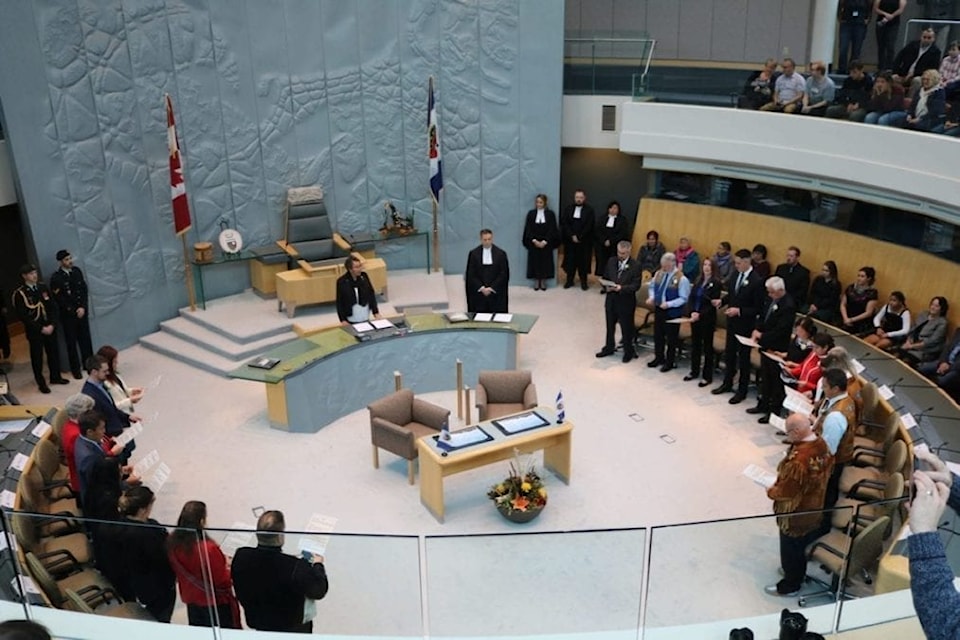In 2015, the newly elected 18th Assembly decided to break with tradition, establishing a revised process for selecting the premier. Good on them. The public had been complaining about the lack of member accountability for some time, many seeing the constituency elections as being little more than localized popularity contests.

The past net result was a gathering of 19 populists in an assembly where ordinary members could claim responsibility for the good outcomes and disclaim any part in failures. Failures, missteps, oversteps or course adjustments made necessary by new information or changing conditions could easily be blamed on cabinet. But here is the disconnect: many forget that the assembly’s caucus (all members of the assembly) hands cabinet its marching orders – essentially its “consensus platform” of priorities for the assembly’s four-year term of office.
The MLAs took a full day in the assembly to share their individual priorities, taking some 62 pages of Hansard (Dec. 14, 2015) to record. The following day, all members of the assembly got together for a mere six hours in-camera to reduce their 62 pages of priorities, rich in detail as to rationale and objectives, into a two-page consensus statement of priorities. The statement provided 26 priorities or objectives grouped under five goals. This was a good beginning but an un-prioritized listing of 26 priorities is not all that useful when it comes to allocating scarce dollar resources against them; the statement becomes subject to the criticism that “if everything is a priority, nothing is a priority; if everything is important then nothing is important.”
Nor are priorities very useful if they reflect the everyday jobs of government, e.g., “Fostering healthy families by focusing on wellness, prevention and improved nutrition” and “Increasing the production and transmission of renewable and alternate energy.” These are “structural objectives”, i.e., what government is about; what is needed are “definitive objectives” to be carried over the life of the assembly, e.g., “Invest $200 million over the next four years on sustainable renewable energy projects in communities to reduce the cost of living and dependence on fossil fuels.”
The statement of priorities is traditionally tabled in the assembly prior to the choosing of a premier and cabinet. The caucus then elects the premier and cabinet to prepare a mandate statement that proposes how they would carry out the assembly’s platform.
To make a comparative example, the caucus statement could be viewed as being an equivalent in content and accountability to the 2015 federal Liberal Party’s platform. The prime minister and cabinet were responsible and accountable to the party members, Parliament as a whole and all Canadians to execute the Liberals’ election promises.
Indeed, they are being held to account in the current election. Are there and where are the responsibility and accountability comparatives in NWT’s consensus government?
I would submit that the accountability and responsibility of consensus government begins to fail almost immediately after the election on a number of accounts beginning right here at the setting of the consensus platform.
Consensus platform lacking
First, the development of a consensus platform lacks rigour as a matter of time invested (approximately six hours) and in the absence of adequate process, i.e., political debate and compromise over planned expenditures and its fiscal plan. A party platform on a national or provincial basis is developed with due process over an extended period of time and with the input of citizens that usually includes prospective candidates for office.
Second, the NWT’s consensus platform is insufficiently detailed before it is handed off from the caucus to the executive branch (cabinet and administration).
Examine the Liberal and Conservatives’ level of detail on its 2019 policy proposals to the voters – it doesn’t just say do more of this or that; it says how much more in estimated dollars, why, who benefits at what cost, how and for how long, and the impacts on the country’s fiscal standing. The NWT voter expects and deserves as much. Voter’s sense of inefficacy has, I believe, resulted in the low and downward trend in voter turnout – a democratic deficit.
Past NWT practice of consensus doesn’t require the foregoing priority setting process, moreover, process and time limitations of current Process Convention on Priority Setting and Reporting -- an evolution of consensus government recommended by the 17th Legislative Assembly followed by the 18th Assembly’s “Lessons Learned” report of the Special Committee on Transition Matters – seems to preclude developing a more detailed consensus platform that would be more directive to the executive branch. Wouldn’t it be wonderful for the MLAs to return to their constituencies after their first two weeks as serving members with something like the 2019 Liberal or Conservative platforms in format and content? They could explain how their own individual platforms have been included in the consensus platform, how their arguments prevailed or if not why not and, if so inclined, promise to fight on. The electorate would know what to expect from the new government and why and be able to provide feedback before budgets are struck.
Consider in 2016 when a surprise reduction of $34 million was expected in the federal formula financing funding to the GNWT. Wouldn’t cabinet and its bureaucracy (executive branch) be better armed to propose changes to the expenditure levels had caucus given initial directions in regard to financing government and a desired allocation of funds in the statement of priorities? The default is that the executive branch (the bureaucracy) becomes the developer of alternative plans that are recommended to accommodate the required allocation of funds against existing and new government programs and initiatives, leaving the premier and cabinet to choose a direction and prepare detailed estimates (the budget) for the upcoming year and forecasts for the future.
Ordinary MLAs then debate a more or less fait accompli, having yielded most of their power to influence and set financial priorities; and therefore, their accountability as part of the caucus, way back shortly after taking office. At this point, the disconnect between the voters, their MLAs’ promises, and the government has pretty much happened, mere months into the four-year term. The only remaining accountability occurs at the two-year review which has proven to be of little consequence again, I submit, due to the inability to measure movement towards the promised objectives.
For the caucus (the legislative branch) to take back and fully exercise its authority to govern and be willing to be accountable for its decisions as a consensus government, that is representative of all, it must spend more time together at the outset to truly set priorities, which includes financial allocations and fiscal management. True priorities have brief descriptions of their scope and rationale, their costing over time, who benefits, when, and how much, and how the priorities are to be financed.
A statement of direction on fiscal management that supports the accomplishment of the caucus priorities should accompany the priorities rather than, as was the case in 2015, MLAs voting for a candidate premier who may or may not have expressed his or her singular view on how the economy and government finances should be managed.
Consensus government has come a very long ways in the NWT, however, if it is to survive rather than being forced to give way to the discord, discontinuous governance and divisiveness of partisan politics, it must continue to evolve.
Happily and positively, we have many voices in this new 19th legislature that believe in consensus government and are determined to make it work better, providing for greater accountability and transparency; thereby, raising the prospect of increased efficacy for the electorate and increasing citizen participation.
